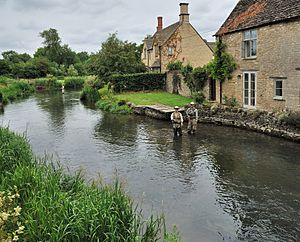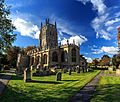Fairford facts for kids
Quick facts for kids Fairford |
|
|---|---|
 River Coln, Fairford |
|
| Population | 3,236 (2011 census) |
| OS grid reference | SP149010 |
| Civil parish |
|
| District |
|
| Shire county | |
| Region | |
| Country | England |
| Sovereign state | United Kingdom |
| Post town | Fairford |
| Postcode district | GL7 |
| Dialling code | 01285 |
| Police | Gloucestershire |
| Fire | Gloucestershire |
| Ambulance | Great Western |
| EU Parliament | South West England |
| UK Parliament |
|
| Website | Welcome to Fairford Town Council |
Fairford is a market town located in Gloucestershire, England. It sits among the Cotswold hills, right by the River Coln. The town is about 6 miles (10 km) east of Cirencester and 9 miles (14 km) north of Swindon. Close by are RAF Fairford and the Cotswold Water Park.
Contents
History
Ancient Times
Long ago, during the Iron Ages, there was a large settlement with roundhouses in an area called Horcott, south of Fairford. An old trade route, the Welsh Way, also passed through the town.
Middle Ages
People have lived in Fairford since at least the 800s. The town was given permission to hold a royal market in the 1100s. This meant it was an important place for trading goods.
After the Norman Conquest in 1066, the land in Fairford became property of the Crown. Later, a powerful Norman lord named Robert Fitzhamon owned it.
In the Domesday Book, a famous survey from 1086, Fairford was called Fareforde. It had three mills, which were important for grinding grain and processing wool. One mill from the 1600s is still standing today.
Important kings like Edward I (in 1276) and Henry VIII (in 1520) visited Fairford. The town even had a prison in the 1200s.
By the 1400s, wool merchants like John Tame managed the land in Fairford.
17th and 18th Centuries
In the early 1600s, most people in Fairford worked on farms or as craftspeople.
Fairford Park, a large estate north of town, was created in the 1660s. It later became a deer park. The park stayed with the Barker family until 1945.
Fairford became a busy stop for stagecoaches. These coaches carried people and goods between big cities like Gloucester, Bristol, Oxford, and London. This meant many inns and places to stay opened up in the town.
19th and 20th Centuries
In 1830, Fairford saw the first Swing Riots in Gloucestershire. These were protests where farmers and workers destroyed new farming machines. They were worried the machines would take their jobs.
During World War II, RAF Fairford was built in 1944 as a base for British and American forces.
After the war, from 1947 to 1959, Fairford became home to about 1,200 Poles. These people had been forced to leave their homes because of the war. The camp was built on the site of a former American Air Force hospital.
21st Century
Iraq War Protest
In March 2003, a large protest called 'Flowers to Fairford' took place. People protested against the use of RAF Fairford by B-52 bombers for bombing Iraq. Thousands of people attended this peaceful event.
Some protesters traveling by bus from London were stopped by police. Later, a court found that the police's actions were against the law. The court said it broke the protesters' rights to speak freely and gather peacefully.
Flooding
In July 2007, Fairford had very heavy rain. This caused major flooding in 64 homes on Milton Street and London Street. Many of the town's yearly events had to be cancelled that year.
Archaeological Discovery
In 2013, a female skeleton was found in the River Coln. Experts believe the remains are about 1000 years old. The woman was likely between 18 and 24 years old when she died. She was found to be of Sub-Saharan origin.
Churches
St Mary's Church
The Church of England parish church of Saint Mary is very famous for its amazing medieval stained glass windows. It also has beautiful stone carvings.
The church was rebuilt in the 1490s by a rich wool merchant named John Tame. It is a great example of late Perpendicular Gothic architecture. This style uses slim stone frames for windows and strong buttresses. This allowed for much bigger windows, letting in lots of light. The church still looks almost exactly as it did when it was built.
Stained Glass, St Mary's Church
St. Mary's church is very important because it has the most complete set of medieval stained glass windows in England. These windows are thought to have been made by an artist named Barnard Flower.
The glass survived the Reformation, a time when many religious images in English churches were destroyed. During the English Civil War in 1642, the windows were almost destroyed again.
Some parts of the windows were damaged in a storm in 1703 and were later fixed. A big project to clean and fix the glass started in 1988 and finished in 2010. Now, clear glass protects the old stained glass.
Churchyard, St Mary's Church
The churchyard has some interesting memorials. There's a stone for Tiddles, a church cat who fell off the roof. There's also a stone carving to remember a young boy who climbed the church walls and fell.
The churchyard also contains eight Commonwealth war graves. These are for soldiers, a sailor, and an airman who died in World War I and World War II.
-
Monumental brass for Edward I Tame in the north wall of the Lady chapel.
-
Tomb with effigies of Katherine Denys and her third husband Roger Lygon of Madresfield.
St Thomas' of Canterbury
Fairford also has a Catholic church called St Thomas of Canterbury. It was built in 1845. The stained glass window behind the altar shows St. Thomas of Canterbury.
Fairford United Church
In 1981, local Methodists and Congregationalists decided to share a church. They officially became one congregation in 1986. This church now follows the traditions of both the Methodist Church and the Congregational Federation.
The churches in Fairford work together through an organization called Churches Together Around Fairford (CTAF). They hold meetings and organize services together.
Governance
Fairford is a civil parish and has a Town Council with 13 members. The mayor is James Nicholls.
Fairford is part of the Cotswold District. It is divided into two areas for local elections: Fairford North Ward and Lechlade, Kempsford and Fairford South Ward. These areas are represented by councillors from the Liberal Democrats party.
Fairford is also represented on Gloucestershire County Council by Conservative Councillor Dom Morris.
Education
The main secondary school in Fairford is Farmor's School. It is a school for students aged 11 to 18. The school has received "Good" ratings in its inspections.
There is also a primary school called Fairford Primary, and a playgroup for younger children. Coln House School, a special school, used to be in Fairford but closed in 2017.
Transport
Fairford used to have a railway line that connected it to Oxford. This line was active from 1873 to 1962. There are now talks about turning part of the old track into a cycle path.
Today, there is a bus service that connects Fairford to Cirencester and Lechlade. From these towns, you can take other buses to places like Swindon.
Media
For local news and TV shows, Fairford gets its signals from BBC South and ITV Meridian.
Local radio stations include BBC Radio Wiltshire and BBC Radio Gloucestershire. Other stations like Heart West and Greatest Hits Radio South West also serve the area. There's also Cotswolds Radio, a community station.
Fairford is served by a weekly local newspaper called the Wilts and Gloucestershire Standard.
Events
Air Tattoo
Every July, RAF Fairford hosts one of the biggest military air shows in the world, the Royal International Air Tattoo. This event brings many visitors and helps the local economy.
Ploughing Championship
The Fairford, Faringdon, Filkins and Burford Championship and Country Show has been held every year since 1948. It's a traditional event that celebrates farming.
Steam Rally
The Ernest Cook Trust used to host the yearly Fairford Steam Rally and Show. This show ran for 46 years but closed in 2015.
Sport and Leisure
Fairford has a non-league football team called Fairford Town F.C. They play at Cinder Lane. There is also a rugby team, FRFC, and a women's netball team.
The town has the Walnut Tree Field, which is a large playing field and park. There's also a cricket club, a bowling club, and clubs for sailing and water skiing.
Fairford also has a youth football club for children aged 5 to 15. It was started in 1976 and is run by volunteers.
Literature
The Secret Diary of Sarah Thomas, 1860 – 1865 is a published journal. It was written by a Victorian diarist who lived in Fairford and mentions local places.
Notable Residents
- Kenton Cool (born 1973) – Mountaineer
- Paul Cornell (born 1967) – Writer
- Frank Cadogan Cowper (1877–1958) – Artist
- Sharron Davies (born 1962) – Swimmer and sports presenter
- Mary Bathurst Deane (1843–1940) – Novelist
- Barbara Dockar Drysdale (1912–1999) – Psychotherapist
- Wills Hill, 1st Marquess of Downshire (1718–1793) – Politician
- Sir Arthur Hirtzel (1870–1937) – Civil servant
- John Keble (1792–1866) – Anglican priest and poet
- Noël Leslie, Countess of Rothes (1878–1956) – Socialite who survived the Titanic disaster
- Mike Winters (1926–2013) – Comedian
See also
 In Spanish: Fairford para niños
In Spanish: Fairford para niños







